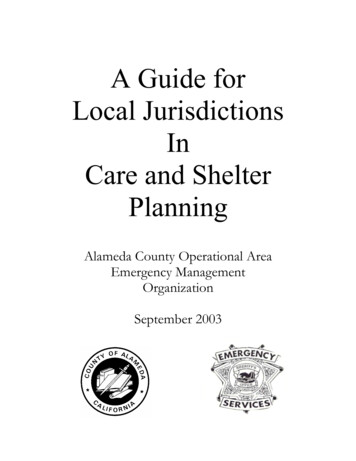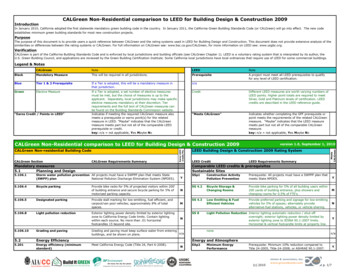
Transcription
A Guide forLocal JurisdictionsInCare and ShelterPlanningAlameda County Operational AreaEmergency ManagementOrganizationSeptember 2003
A Guide for Local Jurisdictions inCare and Shelter PlanningSeptember 2003TABLE OF CONTENTS1. What Is Care and Shelter and Who Provides It? . . 42. Developing Shelter Sites . . . . 93. Organizing A Shelter Operations Team . . 134. Planning to Meet Disaster Shelter Needs . . . 175. Assisting Persons with Special Needs in Disasters . . 306. Building Relationships with CBOs to StrengthenCare and Shelter Operations . . 407. Setting-up Disaster Service Centers to Meet OtherCare and Shelter Needs . 448. Protocols for Opening the Shelter and Laying Out thePhysical Space . . 509. Appendices . . 542
IntroductionThe following guide is written for city personnel involved in care and shelter operations. It isespecially relevant for Care and Shelter Coordinators at the local level. This document isintended for use during the preparedness phase to help guide care and shelter planning. Itprovides all the planning information and guidelines that are relevant for local government’sconsideration before opening disaster shelters. Once shelters are put into operation, the bestresource is the American Red Cross Shelter Operations Workbook, which provides specifics onmanaging shelter operations. Again, this guide is to help local jurisdictions plan for shelteroperations, while also providing an overview of the complete scope of care and shelter services.The core planning elements are the first eight sections. Each section introduces a differentelement of care and shelter planning. Care and shelter personnel can certainly treat the guide asa reference manual and choose from the sections that are applicable to their needs. Half theguide consists of appendices to the first eight sections.A related document is a six-page Care and Shelter Planning Template designed as anaccompaniment to this guide. The Care and Shelter Planning Template lists 20 of the moreimportant action steps for local jurisdictions to take to plan for care and shelter operations.Where appropriate the Care and Shelter Planning Template identifies where to go within thislarger planning guide for further information.Finally, this project was undertaken through the funding and support of the Alameda CountyOperational Area. Primary participants in the development of this guide include the AlamedaCounty Office of Emergency Service, the Alameda County Social Services Agency, the CARDProject of Alameda County and the American Red Cross. The Care and Shelter projectconsultant, Rob Stengel, developed the following document.3
1SectionWhat Is Care and Shelter and WhoProvides It?The function of care and shelter is to provide temporary emergency relief to disaster victims.Providing temporary emergency relief involves a range of emergency human services (e.g., food,shelter, health care, mental health support, etc.).Legal Requirements for Local GovernmentCalifornia law sets the responsibility for emergency care and shelter at the local level. As per theHealth and Safety Code Section 34070 – 34072, local government is to provide or contract withrecognized community organizations to make emergency or temporary shelter available forpeople made homeless by a natural disaster or other emergency. California’s State EmergencyPlan and Standardized Emergency Management System puts local government at the first levelof response for meeting the disaster needs of people in its jurisdiction. People seeking care andshelter immediately after a disaster will look first to local government for assistance.The American Red Cross is a partner with local government in helping to fulfillgovernment’s legal responsibility of providing care and shelter for its citizens in adisaster. The partnership requires that local government and the American Red Cross workcooperatively during the preparedness phase to clarify roles and responsibilities (as outlinedbelow). The local jurisdiction may also work in cooperation with other volunteer disasterassistance organizations to provide disaster relief. However, in a major disaster where there iswidespread damage, the national resources of the Red Cross may not fully mobilize until fivedays after the event. Until such time that the Red Cross arrives on the scene, local governmentwill manage, coordinate, and run all shelter operations.A Cooperative Partnership between Local Government & The Red CrossThe City will:1. Designate a City Care and Shelter CoordinatorThis person will coordinate care and shelter planning and operations for the city.2. Develop a Statement of Understanding with the American Red CrossThe statement of understanding helps to solidify the mutual working partnership betweenthe city and the Red Cross. The Red Cross has a standard agreement for this purpose.4
3. Identify and Survey Shelter FacilitiesWork with the American Red Cross, school districts and other government agencies tocompile an up-to-date list of pre-disaster designated shelters. See Section 2.4. Ensure that Agreements are in PlaceIt is helpful to have statements of understanding with designated shelter sites to clarifyterms of use. Work with the Red Cross to develop applicable agreements. See Section 2.5. Train Staff to Operate Disaster SheltersWork with the Red Cross to provide shelter training to city employees who will staff (andespecially manage) disaster shelters. See Section 3.6. Provide Care and Shelter ServicesResponsibility for care and shelter belongs to local government. While the hands-onmanagement of this task is typically delegated to the Red Cross, cities will need toinitially open and run shelters following a large or countywide disaster. See Section 4.Note: Who to contact at the American Red Cross: For Alameda County, contactthe Disaster Services Manager, American Red Cross, Bay Area, 3901 Broadway Street,Oakland, 94611, Telephone 510-595-4400, http://www.bayarea-redcross.org.The American Red Cross will:1. Provide Care and Shelter Services *By congressional mandate and in accordance with its corporate policy, the Red Cross hasa long-standing disaster relief mission. Red Cross care and shelter services include: *Emergency shelterFixed and mobile feedingEmergency First AidMental Health SupportBlood DrivesDisaster Welfare Inquiry ServicesVouchers for Clothing, Occupational Supplies, Basic Home FurnishingsDisaster Preparedness Education & Shelter Operations TrainingHowever, it may be upwards of 5-days before the Red Cross is fully operational tolaunch these services on a complete countywide basis following a major disaster.2. Provide No-Cost Shelter Training to Members of the CityThe Red Cross provides a 3-hour simulated Care and Shelter Operations Training class.3. Engage in Cooperative Care and Shelter PlanningThe Red Cross will meet regularly with representatives of the city to engage in care andshelter planning and preparedness activities.5
Other Care and Shelter ResourcesAside from the American Red Cross, the following are some of the other county or local resourcesthat may be relevant for supporting local government’s care and shelter response. Cities mayaccess county resources through the Op Area Emergency Operations Center (EOC).1. County Health Care Services AgencyThe County Health Care Services Agency encompasses a variety of program areas -Medical Care, Behavioral Care, Public Health and Environmental Health.Public and Environmental Health provide the following disaster response functions: Acts to prevent the spread of communicable disease and disaster-related illness.Makes public health nursing services available to disaster shelters.Addresses food and water safety and sanitation issues in shelters.Monitors, assess and reports on the community disaster health status.In addition, Public Health's Emergency Medical Services (EMS) coordinates theimmediate emergency medical response in a disaster, including emergency medicaldispatch, emergency and non-emergency ambulance services.2. County Behavioral Health Care ServicesManages the following disaster mental health response functions: Assesses and activates the response to disaster mental health issues.Makes counselors available to shelter facilities to provide mental health services.Ensures the continuation of care, treatment and housing for those clients currentlyresiding within the Mental Health System.3. County Social Services Agency (SSA)SSA is the lead agency for care and shelter response at the county level. SSA can supportlocal government with additional staff to operate disaster shelters.The following SSA services support more vulnerable county residents.(In times of disaster, these programs can supplement the response of local jurisdictions topersons with special needs) -- services to seniors and people with disabilities.Adult Protective Services (APS) -- services to adults with developmental disabilities,including mentally disabled adults and elderly persons.Child Abuse & Children's Protective Services -- services for children who are victimsof neglect or lack family care (such as without family supervision post disaster).In-Home Supportive Services (IHSS) -- in-home care services to low income elderly,blind and disabled persons.Public Authority for IHSS -- provides a registry of screened home care providers forIHSS recipients/consumers.Area Agency on Aging (AAA)6
In addition, SSA has programs for Child Care, General Assistance, Medi-Cal,Housing Assistance, Food Stamps, and SSI, which disaster victims may need as partof their recovery.4. CARD of Alameda County (Collaborating Agencies Responding to Disaster)CARD improves the disaster preparedness of community based organizations servingvulnerable populations. In a disaster, CARD becomes the link between requests foremergency help and the community-based organizations available to provide help.CARD will ensure an effective response and recovery for vulnerable and under-servedpopulations in Alameda County. See http://www.PrepareNow.org.5. Community Based Organizations (CBOs)CBOs that provide direct and ongoing services to persons with special needs during nondisaster times are in the best position to support the recovery of more vulnerablepopulations following a disaster. CBOs may support local jurisdictions with sheltering,language and cultural sensitivity needs, and serve as a conduit for getting information topeople that local government may have difficulty reaching. See Appendix G – IdentifyingCBOs and Community Resources.6. Salvation ArmyThrough its various local organizations and with the assistance of Divisional Head quarters, 916-563-3700, or www.salvationarmydeloro.org, the Salvation Army providesthe following services to individuals and families. Mass care feeding (including mobile kitchen units) Sheltering Clothing distribution Counseling Assistance in home cleanup (for seniors and people with disabilities)7. Local Business and IndustryBusinesses often donate goods or services to assist the community in its recovery from adisaster. Cities may establish pre-disaster agreements with local businesses to expeditethe purchase or use of equipment and supplies required for shelter operations.Care and Shelter Planning AssumptionsCare and shelter personnel must keep these assumptions in mind when planning for disasters. That responsibility for care and shelter belongs to local government. However,the American Red Cross and Salvation Army, along with other CBOs and voluntaryorganizations, may assist local government as partners in delivering these services. In a major disaster, the American Red Cross will require an influx of resourcesfrom outside the area to be operational. Therefore, it may be upwards of 5 daysbefore the Red Cross can assume a primary care and shelter role.7
In accordance with SEMS, additional resources and assistance from outsidethe local jurisdiction shall be available to local government through the OpArea. However, expect resources to be extremely limited the first few days following adisaster where there has been widespread damage. Local jurisdictions will fare better inthe short term by developing their own local resource base. In the immediate days after a major disaster, neighborhood organizations and localcongregations will emerge to provide care and shelter support independent oflocal government. Local government will need to coordinate care and shelter serviceswith those groups that emerge spontaneously. Some displaced residents will converge on public parks and open spaces, as analternative to using indoor mass care shelters. Many residents who suffer some structural damage to their home, following amajor disaster, will choose to remain on their property (i.e., camp-out), versusgoing to a public disaster shelter. Yet, they will still have needs and expectations fordisaster assistance from local government. Given the above, in addition to opening disaster shelters, cities will need toopen disaster service centers (as a place for local residents to go for disasterassistance). See Section 7: Setting-up Disaster Service Centers to Meet Other Care andShelter Needs. CBOs that provide social services and serve vulnerable populations willinitially be overwhelmed with demands for service, but will do everything possible tomeet new and emerging community needs. Local government can support this effort byusing its EOC to obtain the resources that CBOs need to sustain operations post-disaster. A disaster that occurs while school is in session may require the school tobecome a temporary shelter for its student population. Either alternative shelteris needed for the general population, or the public may have to identify a separate areawithin the school building so that two separate shelter operations are occurringsimultaneously. Essential public and private services will continue during shelter and masscare operations. However, for a major disaster that generates a very large-scale shelteroperation, normal activities at schools, community centers, churches and other facilitiesused as shelter sites will be curtailed.8
2SectionDeveloping Shelter SitesWork with the American Red Cross to identify and survey local facilities that may be used toshelter persons in a disaster. The Red Cross has a list of potential shelter sites throughoutAlameda County, including agreements with various facilities. At a minimum, each city needsits own list or inventory of shelter facilities with basic facility data on (1) capacity, (2) bathroomsand showers, (3) ADA accessibility, and (4) floor plans.Examples of Potential Shelter Sites1. Public and Private School Buildings- School gymnasiums and large multipurpose rooms are ideal for sleeping areas2. City-Owned Facilities- Community centers, senior centers, recreational facilities, or auditoriums3. Congregations- Churches, temples, synagogues or other privately owned facilitiesUse of School Buildings: California law, as stated by the "Katz Bill", requires public andprivate school districts and school authorities to make their facilities available as public sheltersites in a declared disaster. This makes school facilities, especially larger high school buildings,a logical first choice for shelter operations in an event where there has been widespreaddestruction. However, use schools as public shelters only when other resources are unavailable.First, schools may already be sheltering their own student population. Second, a communityneeds to resume normal activities as soon as possible after a disaster. Therefore, in short timethe shelter population will need to be moved from the school, so that students can ultimatelyreturn to classes.Other Building Options: Because the city has ownership of these facilities, communitycenters and other public facilities are also a logical choice as shelter sites. However, Recreationand Park sites are smaller than schools and some facilities lack adequate bathrooms and showers.Senior centers are the smallest of all and as disaster shelters, they can accommodate only 50 to70 persons. Local congregations are another option as many congregations have classrooms andlarge multipurpose rooms, in addition to kitchen facilities. Start with neighborhoods whenidentifying potential shelter sites. The ideal plan designates potential shelter sites within eachneighborhood of the local jurisdiction.9
Criteria for Selecting Shelter SitesIdeal shelter facilities have the following characteristics.1. Space for parking2. Space for Sleeping (40 square feet per person)In addition, envision space for the following within the facility:-Registration AreaShelter Manager’s OfficeHealth Services AreaMental Health Services AreaFood Preparation or Serving Areas (including space for a snack table)Recreation Area3. Toilet and Shower Facilities (one toilet per 40 people)4. Kitchen / Cooking Facilities5. Emergency Generator on Site6. Safety Features (e.g., fire extinguisher, fire sprinklers and fire alarm)7. Building Heating and Cooling Capacity8. Telephones9. Accessibility for People with Disabilities-See Appendix F - Tips to Maximize Shelter Accessibility, for more information onADA requirements and reasonable accommodations.10. Secured Storage Areas11. Separate Rooms within the Facility (e.g., private space for elderly persons, families withchildren, or persons that need isolation; also rooms for nursing and office space)Note: Consider sites that meet all the above standards as "Primary Shelter Facilities"Survey of Shelter SitesComplete a Shelter Facility Survey of designated shelter sites in conjunction with the AmericanRed Cross (use Red Cross Form #6564). In addition to capturing the information above, thesurvey will identify the following.1. Location and Contact Information2. Resource Information-Total Shelter Sleeping Capacity (Number)Note: Figure capacity at 40 square feet per person. Therefore, a 10,000 squarefoot gymnasium has sleeping space for 250 persons.Showers (Yes/No)Number of bathrooms (Number)10
-Accessibility for people with disabilities (Yes/No/Partial)3. The survey will also identify what supplies may already be on site (e.g., sleeping mats,blankets, food and water, cleaning supplies, etc.)4. As part of the survey, obtain a floor plan for each facility designating areas for shelteroperations.Open Space Shelter SitesTo accommodate large numbers of displaced persons, some jurisdictions may want to designateareas for camping, or setup tents in parks and other open space areas. Given the work involvedto create the necessary infrastructure (i.e., electricity, sanitation, water, cooking, security, etc.)along with the public health implications, think of this option as a last resort for sheltering.Sheltering residents in existing buildings, where a basic infrastructure is already in place,remains the first and best option.Setting up camping areas will require much logistical work to negate the sanitation, hygiene andenvironmental health issues. The first question is what are people going to use for bathroomfacilities? Portable toilets must be put in place immediately. Secondly, disease is going to beharder to control and will spread more easily. Then there is the challenge of providing mealsalong with all the other shelter services discussed earlier (e.g., health, mental health, information,and other personal services). Finally, it is also going to be more difficult to meet special needs inan outdoor environment. Ultimately, the Northridge experience was that once established thesecampsites are hard to disperse.Alternative Shelter Sites1. Smaller Neighborhood SitesWhat about people whose needs, safety or well being would be better served in smallersettings, with perhaps a higher level of care than we can provide at mass care sites? It makessense to pre-plan for sites that would supplement primary mass care shelter facilities -- inother words, alternative sites. Local congregations are ideally suited to serve as alternativesites, because they have space and the basic facilities to accommodate public gatherings(bathrooms, accessibility and kitchen areas); plus they are located throughout neighborhoods.Since most congregations lack shower facilities, their use would be more of a short-term ortemporary option.In cases where community residential programs or care facilities need to evacuate, but staffand caregivers want to stay in tact, it makes sense to set them up at alternative sites, versusputting their population into a mass care setting. This is particularly true of programs likegroup homes or board and care facilities that serve seniors, adults with disabilities, youth andother persons with special needs. In essence, program staff, residents and the necessaryresources are all relocated to the alternate site, where staff will continue to support theirresident population.11
2. Medical Care SitesThe County Health Care Services Agency may designate specific shelter sites to care forpersons who are medically fragile and who need a higher level of care and supervision thanthat which is available at public shelter sites. Shelter staff will include a combination ofPublic Health Nurses, Red Cross and Social Services staff.Primary and Secondary SitesIn opening disaster shelters, local jurisdictions need to designate between primary and secondaryshelter sites.Primary Sites. Primary sites meet most of the criteria identified earlier in this section. Theycan handle larger numbers of shelter residents and are accessible for persons with disabilities(e.g., a person using a wheelchair can enter the facility and access all service areas -- eating,sleeping, bathrooms and showers). Obviously, primary sites receive priority status when there isa need to open disaster shelters, so the larger the pool of primary sites the better.Secondary Sites. Conversely, secondary sites do not meet all criteria, yet they may beadvantageous for neighborhood-based sheltering and with some modifications can fullyaccommodate persons with disabilities. See Appendix F - Tips to Maximize ShelterAccessibility, for more information on ADA requirements and accommodations.Shelter AgreementsAlthough schools are required by law to serve as shelters in a declared emergency, it is stillhelpful to have statements of understanding with both school districts and other private facilities.The American Red Cross has a Statement of Understanding that can be used for this purpose. Itestablishes understanding on the following points of operation.1. Authorization for use of the facility and procedures for notification.2. Describes terms of use for equipment at the facility -- radios, fax machines, televisions,computers, etc. Also, describes any reimbursement or arrangements for use of utilities (gas,water, electricity and telephones).3. Discusses the length of use (use for as short a period as possible; continued use of the facilitywill be based on the mutual decision of both parties).4. Emphasizes return of the facility to its original condition, including the replacement orreimbursement for any damage or materials/supplies consumed during the shelteringoperation.5. Defends, holds harmless, and indemnifies the facility against any legal liability for actionsthat occur during the sheltering operation.12
3SectionOrganizing A Shelter Operations TeamAside from the actual facility, the next most critical component to operating a disaster shelter isthe shelter management team. This section will discuss the formation, training and job duties ofa shelter operations team.SEMS Profile of a Shelter Management TeamThe most important part of the team is the shelter manager. In opening a disaster shelter, theshelter manager’s first responsibility is to assign available staff to fill the following functions.Command/MgmtShelter ManagerOperationsPlanningLogisticsIncludes thesefunctions.The ShelterManager mayassume thesefunctions.Obtains theresources forshelteroperations. Maintainsliaison w/ EOC Obtains information asneeded below Anticipatesshelter needsand developsaction plans tomeet needs RegistrationFood ServicesDormitoryFirst Aid/Med.Mental HealthOther ShelterServices- Recreation- Child Care- Pet Care- Security &SafetyPersonnelFood & WaterTransportationSupplies &Equipment Communication Services forshelterresidentsFinance &AdminManages thefollowing: Maintainsfinancialrecords anddocumentationof claims,costs and time Sets up vendorcontracts ProcessesPurchaseOrdersPlanning Notes:A. See Appendix J - Shelter Management Team Job Duties for a more detailedchecklist of job responsibilities.13
B. Consider designating an Assistant Shelter Manager, in addition to the ShelterManager, especially for large shelter operations.C. The Red Cross recommends a minimum of 6 staff per 100 shelter residents.Depending on the size of the disaster and the number of staff available, some positionsmay do double-duty, or shelter residents and community volunteers can fill selected roles.D. By law, all government workers serve as disaster workers in a declaredemergency.Formation of the Shelter Management TeamThe following summarizes the tasks involved with forming the shelter management team.Presumably, the city’s care and shelter coordinator will perform these planning tasks.1. Identify a Corps of Shelter Managers Given that good shelter management is a key to successful shelter operations, begin byselecting (or designating) a corps of city shelter managers and assistant shelter managers.Consider the following criteria in selecting shelter managers. If possible, choose persons who, in a disaster, will be managing the same facility(or facility of a similar type) that they normally manage during non-disaster times.For local jurisdictions, shelter managers will presumably come from Parks andRecreation or Community Services staff. Choose persons with good supervisory or management skills who can handlestressful conditions. They also must be persons who can deal sensitively with adiverse shelter population given the demographics of our urban communities. Include shelter managers in training below.2. Identify Additional Shelter Operations Staff for Training If Parks and Recreation (or similar entity) is the city department tasked with care andshelter response, recruit staff from that department to receive Red Cross Shelter Training. Otherwise, the care and shelter coordinator will want to work with the city’s emergencyservice coordinator to determine which city personnel to recruit for shelter training. Ifthere are city employees who do not already have clearly defined response roles in adisaster, consider training them to serve as city disaster shelter workers. Identify and train city employees with more specialized skills needed to support shelteroperations (bilingual employees, employees with First Aid, mental health training, etc.). Involve school district personnel in shelter training. In cases where schools becomedisaster shelters, school personnel may assist as shelter workers. Invite key CBOs, or local congregations that may operate shelters, to participate inshelter training. Considering inviting community/city volunteers for training as care andshelter workers in a disaster14
3. Setup a Shelter Training Class Conducted by the Red Cross Contact the American Red Cross Chapter in Oakland, 510-595-4400, to arrange a sheltertraining class. The Red Cross Shelter Training and Simulation Class is 3-hours in length and providesinformation on how to run a successful shelter operation, along with a tabletop exerciseto practice operations. Objectives of the training are to enable city employees to: Demonstrate how to open and operate a shelterIdentify a variety of resources available to shelter workersWork as a team to provide quality shelter services to shelter residentsEffectively address common shelter problems Participants at the training will receive the Red Cross Shelter Operations Participant’sWorkbook. This workbook provides the tools to open and operate a shelter in times of anemergency when an experienced shelter manager is not available.4. Maintain an Active Roster of Shelter Workers Once employees complete training as shelter workers, add them to the list of activeshelter workers. Keep this list up-to-date. Consider some type of annual disaster training for shelter workers.Note: See Section 8: Protocols for Opening the Shelter for more information on thedeployment procedures of shelter staff in an emergency.Personal PreparednessEach person needs to be responsible for his or her own personal disaster preparedness. Asdisaster service workers, city employees must have a self and family preparedness plan in place.Without being prepared at home, you cannot serve effectively in city shelter operations.At a minimum, individual preparedness requires the following. An Evacuation PlanAn Out-of-Area Contact PersonEnough emergency supplies to last 3-days at home and workRefer to the following Red Cross documents for further information: Family Disaster beprepared/familyplan.html Disaster Supplies pared/supplies.html Food Supplies in Case of beprepared/food.html15
Your Evacuation epared/evacuation.html Food and Water in an /beprepared/foodwtr.html Personal Workplace Disaster Supplies pared/workkit.html Emergency Preparedness /foreignmat/epceng.pdf16
4SectionPlanning to Meet Disaster Shelter NeedsThis section provides an overv
The American Red Cross will: 1. Provide Care and Shelter Services * By congressional mandate and in accordance with its corporate policy, the Red Cross has a long-standing disaster relief mission. Red Cross care and shelter services include: Emergency shelter Fixed and mobile feeding Emergency










